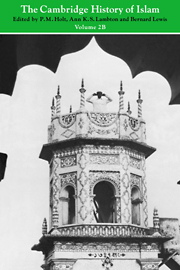Book contents
- Frontmatter
- Introduction
- PART VIII ISLAMIC SOCIETY AND CIVILIZATION
- 1 THE GEOGRAPHICAL SETTING
- 2 THE SOURCES OF ISLAMIC CIVILIZATION
- 3 ECONOMY, SOCIETY, INSTITUTIONS
- 4 LAW AND JUSTICE
- 5 RELIGION AND CULTURE
- 6 MYSTICISM
- 7 REVIVAL AND REFORM IN ISLAM
- 8 LITERATURE
- (a) ARABIC LITERATURE
- (b) PERSIAN LITERATURE
- (c) TURKISH LITERATURE
- (d) URDU LITERATURE
- 9 ART AND ARCHITECTURE
- 10 SCIENCE
- 11 PHILOSOPHY
- 12 WARFARE
- 13 THE TRANSMISSION OF LEARNING AND LITERARY INFLUENCES TO WESTERN EUROPEo
- Dynastic List
- Bibliography
- Glossary
- Index
- References
(d) - URDU LITERATURE
from 8 - LITERATURE
Published online by Cambridge University Press: 28 March 2008
- Frontmatter
- Introduction
- PART VIII ISLAMIC SOCIETY AND CIVILIZATION
- 1 THE GEOGRAPHICAL SETTING
- 2 THE SOURCES OF ISLAMIC CIVILIZATION
- 3 ECONOMY, SOCIETY, INSTITUTIONS
- 4 LAW AND JUSTICE
- 5 RELIGION AND CULTURE
- 6 MYSTICISM
- 7 REVIVAL AND REFORM IN ISLAM
- 8 LITERATURE
- (a) ARABIC LITERATURE
- (b) PERSIAN LITERATURE
- (c) TURKISH LITERATURE
- (d) URDU LITERATURE
- 9 ART AND ARCHITECTURE
- 10 SCIENCE
- 11 PHILOSOPHY
- 12 WARFARE
- 13 THE TRANSMISSION OF LEARNING AND LITERARY INFLUENCES TO WESTERN EUROPEo
- Dynastic List
- Bibliography
- Glossary
- Index
- References
Summary
Urdu is the language spoken by the Muslims and by certain non-Muslim elements in the urban areas of West Pakistan and north-western India. It is the chief literary language of the Muslims of the subcontinent. The name ‘Urdu’ is of Turkish origin, familiarized in Persian by the Il-Khanid historians, and adopted in India by the Sayyid ruler Khizr Khān (817–24/1414–21) for his army and court under Timurid influence. During the reign of the Great Mughals in India it came to be applied generally to the imperial camp, and during the late eleventh/seventeenth century to the language the camp spoke.
The language itself and its earlier regional literatures are much older than its present name. From the thirteenth to the eighteenth century it was referred to as ‘Hindawī’ or ‘Hindī’ or given dialectal names, ‘Dakhanī ’ and ‘Gujarātī’. This is rather confusing as its philological and literary growth remained quite distinct from the languages known today as Hindī or Gujarātī.
It is descended from one or more dialects of the Indo-Aryan Śawraseni Prākrit. It was evolved by the Indian Muslims for communication with Hindu fellow-citizens in town and country, and for use in the harems in which were Hindu women as wives, concubines or domestics.
The origins of Urdu date back to the period of Ghaznavid rule in the Panjāb in the sixth/twelfth century. The Muslims wrote it in Persian script. While they retained much of its grammatical structure and essential verbs, adjectives and adverbs, unrestrained borrowings from Persian, and through Persian from Arabic and to some extent Turkish, gave it a pronounced Muslim linguistic and literary character.
Keywords
- Type
- Chapter
- Information
- The Cambridge History of Islam , pp. 695 - 701Publisher: Cambridge University PressPrint publication year: 1977

